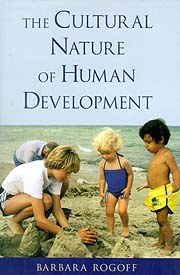|

 


|
March 24, 2003
New book shows how culture shapes human
development
By Jennifer McNulty
The thought of young children handling knives makes many American
parents
shudder, yet toddlers in parts of Africa safely use machetes.
Similarly,
infants in middle-class communities in the United States are
often expected
to sleep alone by the time they're only a few months old, while Mayan
children typically share their mother's bed through their toddler
years.
|

|
| Although there is more variation in child development
than psychologists have written about, the variation is not random,
notes Barbara Rogoff. |
These striking differences in child-rearing practices reflect the
diverse range of what is considered developmentally appropriate for
children around the world, depending on their cultural circumstances.
The contrasts reveal the extent to which notions of human development
are culturally defined, says Barbara Rogoff, a UCSC professor of psychology
and author of the new book The Cultural Nature of Human Development
(New York: Oxford University Press, 2003).
"All children grow as members of cultural communities," said
Rogoff, an expert on learning and development who holds the UC Santa
Cruz Foundation Chair in Psychology. "So understanding how childhood
is supported, constrained, and constructed in any community is part
of understanding child development."
Research on human development has tended to focus on determining when
children are capable of certain skills without examining the cultural
processes that shape their development, said Rogoff. Coupled with the
assumption that "early is good, late is bad," age-related
theories of child development become problematic. "The racetrack
approach often has damaging effects on children," she said.
The very notion of familiar developmental "milestones," such
as the ability to sleep independently, walk and read by certain ages,
and "move away from home" in early adulthood, reflects European
American middle-class culture.
"People think that what they have experienced is natural,"
explained Rogoff. "It's normal to take one's own community's ways
for granted, but that involves cultural blinders. Once we look beyond
our own assumptions, it becomes clear that there is not just one best
way, as tempting as it is to think there is."
Although there is more variation in child development than psychologists
have written about, the variation is not random, noted Rogoff. "One
of the aims of my book is to go beyond saying 'culture matters' and
begin to describe the regularities involved in the cultural variations,"
she said. For example, a key variable is whether children are routinely
included in the range of events of their community or are often segregated
into specialized child-focused settings.
The United States is a highly age-segregated society, with children
spending much of their time away from the activities of adults. That
segregation removes children from important opportunities to observe
and learn from elders by participating in valued community activities,
said Rogoff. In communities that are age-segregated, childhood is often
viewed as 'preparation' for later entry into the adult world, she noted.
Adults arrange for children's involvement in exercises--in school or
at home--to prepare for community involvement in adulthood.
In contrast, Rogoff was struck by what she has observed during nearly
30 years of research in a Mayan community in Guatemala, where children
often learn through a process of observation and supportive guidance
as they engage in community activities. Young Mayan girls, for instance,
regularly observe women weaving complicated patterns because weaving
is a daily household activity. Experienced weavers watch for their daughters
to express interest and then set up a simple weaving project beside
their own, which allows them to offer what Rogoff calls "guidance
embedded in activity."
Unlike in middle-class communities in the U.S., where learning is often
pegged to age and managed in specialized child-focused settings, instruction
in this Mayan community is generally triggered by the child's interest
in becoming involved in valued family and community activities. "Measuring
development with age milestones has been foreign because, until recently,
many people have not kept track of how old they are," said Rogoff.
Compulsory schooling has embedded the chronological approach to child
development in the U.S. over the past 150 years. For bureaucratic efficiency,
schools segregate children into narrow age groups and process their
learning by age, an approach that plays into adult concerns about the
speed of development.
Developmental psychologists have much to learn from a more culturally
inclusive approach to human development, said Rogoff. And, she suggests
in The Cultural Nature of Human Development, children benefit
from opportunities to engage responsibly with people of all ages and
to learn by contributing to valued community activities, regardless
of their age.
Rogoff holds the UC Santa Cruz Foundation chair in Psychology.
Return to Front Page
|
|